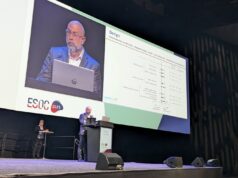
Although intensive blood pressure lowering with intravenous thrombolysis is safe in patients with acute ischaemic stroke, the observed reduction in intracranial haemorrhage did not lead to improved clinical outcome compared with current guideline treatment, according to late-breaking science presented at the International Stroke Conference (ISC; 5–8 February, Honolulu, USA). Simultaneously published in Stroke, this large international clinical trial was presented by Craig Anderson (University of New South Wales, Sydney, Australia) and Thompson G Robinson (University of Leicester, Leicester, UK).
Speaking to the ISC audience, Anderson alluded to the long standing uncertainty in relation to optimal blood pressure control: “We do not know whether any benefits from a more intensive treatment, particularly in regards to reducing the risk of intracerebral haemorrhage, may be offset by harms of promoting cerebral ischaemia in the vulnerable ischaemic penumbra”
The international, randomised, open-label blinded-endpoint phase 3 trial: Enhanced control of hypertension and thrombolysis stroke (ENCHANTED), aimed to examine the superiority of a more intensive regime to a less than 140mmHg systolic target, against the long standing guideline criteria of less than 180mmHg systolic target after recombinant tPA (alteplase). The study included tPA-eligible acute ischaemic stroke (less than 4.5 hours of onset) whose blood pressure remained elevated beyond 150 and who could receive randomised blood pressure treatment within six hours of stroke onset.
“The intensive treatment had the goal of getting the blood pressure range of less than 140mmHg within an hour, and to sustain that to up to 72 hours using local agents”, noted Anderson. “This was tested against local interpretation of the guideline criteria in the control group”. Ten subgroups were pre-defined to examine any interaction of the treatment effect (interaction with the rtPA dose), while the ENCHANTED investigators used both central and site monitoring of the accumulated data for quality control purposes.
The primary outcome was an ordinal shift analysis of the full range of scores on the modified Rankin scale (mRS) at 90-days, while the primary safety measure was any intracranial haemorrhage. “We estimated that a sample size 2,100 patients would provide 90% power to determine a 14% relative shift in the primary outcome, and a 40% reduction in the primary safety measure”, said Anderson.
In total, 2227 patients were recruited between 2013 and 2018. Due to data irregularity, 31 patients were excluded, leaving 1,081 patients in the intensive arm (mean age: 67 [50–75]; 37% female), and a further 1,115 in the control group (mean age: 67 [59¬76]; 39% female). According to Anderson, the baseline characteristics of the two groups were well balanced; “the median NIHSS score was 7 (4–12) in the intensive arm, and 8 (4–12) in the controls; more than two thirds of patients had either large artery atheroma or small vessel cerebrovascular disease”.
Robinson proceeding to present the main results of ENCHANTED, and acknowledged the lack of superiority for the primary functional outcome: “There was no difference in the mRS shift at 90-days between arms with an adjusted odds ratio of 1.01 [95% CI: 0.87, 1.17; p=0.87]”. He noted that this neutral result was confirmed in both the adjusted and the per protocol analysis: “There was no significant heterogeneity of the primary outcome—with respect to age, ethnicity, baseline systolic blood pressure, ischaemic stroke subtype and dose of tPA”.
Addressing the “long standing concerns” regarding the effect of intensive blood pressure reduction in severe stroke, Robinson said: “We undertook a post hoc analysis by grades of neurological severity (quartiles of NIHSS scores), and this did not affect the primary outcome”.
However, intracranial haemorrhage was statistically significantly lower in the intensive arm, while across a range of definitions of symptomatic intracerebral haemorrhage, these rates were also lower. “Of importance, there was no increased adverse events with the intensive blood pressure lowering arm”, Robinson added.
In light of the findings, he said: “There were a number of issues that I think we need to consider”. He suggested that the results were influenced by the difference in blood pressure management between the patient groups—being less than planned, with many patients in the standard treatment group receiving more blood pressure management lowering than typically used in clinical practice.
Addressing the ISC audience, he questioned the clinical implications of these results. “There is perhaps no evidence to support a major change in the guidelines, but it appears that clinicians are to some extent already more comfortable about control of blood pressure more intensively in this patient group, and it is important to state that the treatment is clearly safe and reduces the risk of intracranial and intracerebral haemorrhage”.
Although Robinson said that “ENCHANTED has not fully resolved the uncertainty for the optimal level of blood pressure control, [or] the approach which one should use in terms of promoting recovery”, he postulated that in terms of moving this intensive approach forward: “We need to do further research on our extensive brain imaging databases to understand why this reduction in haemorrhage did not overall translate into better recovery”.










